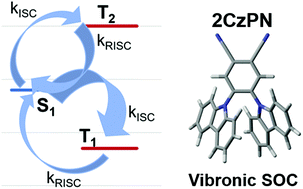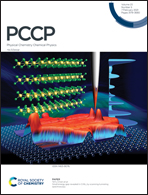Intersystem crossing processes in the 2CzPN emitter: a DFT/MRCI study including vibrational spin–orbit interactions†
Abstract
Multireference quantum chemical calculations were performed in order to investigate the (reverse) intersystem crossing ((R)ISC) mechanisms of 4,5-di(9H-carbazol-9-yl)-phthalonitrile (2CzPN). A combination of density funcional theory (DFT) and multireference configuration interaction methods (MRCI) was used. The excellent agreement of the computed absorption spectrum with available experimental absorption spectra lends confidence to the chosen computational protocol. Vertically, two triplet excited states (T1 and T2) are found below the S1 state. At the excited state minima, the calculated adiabatic energies locate only the T1 state below the S1 state. The enhanced charge transfer (CT) character of the geometrically relaxed excited states causes their mutual (direct) spin–orbit coupling (SOC) interaction to be low. Contributions of vibronic SOC to the (R)ISC probability, evaluated by a Herzberg–Teller-like procedure for a temperature of 300 K, are small but not negligible. For ISC, the S1 → T1 channel is the fastest (8 × 106 s−1), while the S1 → T2 channel is found to be thermally activated (9 × 104 s−1) and less efficient when proceeding from the adiabatic S1 state. Our calculations also reveal, however, a barrierless S1 → T2 ISC pathway near the Franck–Condon region. RISC is found to essentially proceed via the T1 → S1 channel, with a rate constant of (3 × 104 s−1) if our adiabatic singlet–triplet energy gap in vacuum (ΔEST = 0.12 eV) is employed. Shifting the potentials to match two experimentally reported singlet–triplet energy gaps in toluene (ΔEST = 0.21 and 0.31 eV, respectively) leads to a drastic reduction of the computed rate constant by up to 4 orders of magnitude. The T2 state is not expected to play a major role in mediating triplet–singlet transitions in 2CzPN unless it is directly populated by hot excitons. No indication for a strong vibronic coupling of the T2 and T1 potentials is found, which could help overcome the negative exponential dependence of the RISC rate constant on the magnitude of the energy gap.



 Please wait while we load your content...
Please wait while we load your content...